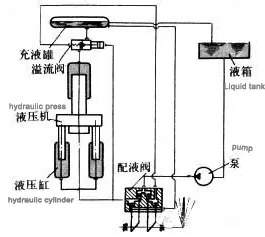
The oil pump provides high-pressure working fluid to the hydraulic cylinder, the distribution valve is used to change the direction of the liquid supply, and the overflow valve is used to adjust the limited pressure of the system, and at the same time play a role of safety overflow. After the hydraulic oil is distributed to the upper chamber or the lower chamber of the cylinder, the cylinder is moved under the action of high-pressure oil. Drive the movable beam to move or the ejector cylinder to move. Four column hydraulic presses generally have two processes: semi-automatic process and stretching process. Semi-automatic process action: slide down fast → slow down → pressing (holding pressure) → pressure relief return → ejection → billet removal. Stretching process action: Ejection→slider fast down→slow down→pressing (holding pressure)→pressure relief return→ejection→billet removal. The two process actions are very similar. When the slider moves down quickly, the oil pressure is low and the current is small; when the slider moves down slowly, the pressure suddenly increases; The pressure of follow-up actions such as pressing the return stroke is very small, so it goes back and forth. Core requirements The four-column hydraulic press used to operate at power frequency. Due to the large power consumption, large pressure shock and easy damage of components in the equipment, hydraulic press manufacturers are now gradually switching to frequency conversion operation.
After using frequency conversion control, the following three points must be met:
1. Can maintain pressure for a long time under large hydraulic pressure (overload capacity must be strong)
2. The speed can be kept stable when the pressure continues to increase
3. Energy saving, low hydraulic impact, and long mechanical life. The solution is based on the technological characteristics of the four-column hydraulic press, the requirements for overload capacity and speed stability.
When debugging, pay attention to the following points:
High pressure and stable speed are required during pressing, so vector control is required.
The four stages of downlink, suppression, idle, and return adopt four-stage speed control, and the speed difference is not too large to ensure that the system runs smoothly and the impact is small.
Considering that when the end user's site voltage is low, the 50Hz voltage may not be able to reach 380V, and the torque will be reduced. It is recommended to set the pressing speed between 45 and 50Hz.
The speed stability during pressure holding can be solved by reducing the current controller 1 and increasing the current controller 2.


 +86-769-8306-1993
+86-769-8306-1993
 E-mail
E-mail
